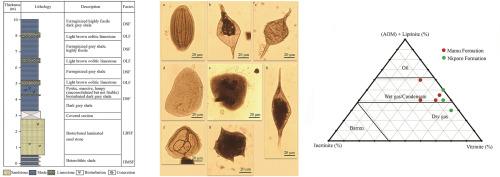Hydrocarbon source rock potential of the Late Cretaceous sediments in the Asaga–Ohafia Axis, Afikpo Basin, Nigeria: Insights from facies and kerogen analyses
IF 3.6
引用次数: 0
Abstract
This study investigated the hydrocarbon source rock potential of the Late Cretaceous Mamu and Nkporo formations in the Asaga–Ohafia Axis, Afikpo Basin, southeastern Nigeria, using integrated facies analysis, organic geochemical and palynofacies data. Five lithofacies were identified: dark grey shale, oolitic limestone, heterolithic mudstone/sandstone, laminated bioturbated sandstone, and calcareous mudstone, indicating estuarine, deltaic, and shallow marine depositional environments. Total organic carbon (TOC) contents range from 1.47 to 2.40 wt%, which reflects moderate to good organic richness. For the Mamu Formation, kerogen composition is dominated by Type II/III, composed of 30 %–50 % amorphous organic matter (AOM), 5 %–10 % liptinite, 30 %–50 % vitrinite, and 10 %–20 % inertinite. Spore coloration and Thermal Alteration Index (TAI: 3–3+) suggest thermal maturity within the oil window (Ro: 0.80 %–1.50 %). In contrast, the Nkporo Formation shows comparable kerogen composition (20 %–45 % AOM, 0–20 % liptinite, and 40 %–65 % vitrinite) but lower maturity (TAI: 2–2+; Ro: 0.45 %–0.80 %). Rock–Eval pyrolysis further supports these findings. The Mamu Formation displays higher Hydrogen Index, favorable Tmax, and Production Index values, confirming its maturity and oil and gas–prone potential. Palynological assemblages, including marine dinoflagellate cysts (Mamu Formation) and freshwater algae/fungal spores (Nkporo Formation), align with the inferred depositional settings. Thus, the Mamu Formation is the more prolific source rock, characterized by superior organic quality and thermal maturity.

尼日利亚Afikpo盆地Asaga-Ohafia轴晚白垩世沉积物烃源岩潜力:来自相和干酪根分析的见解
利用综合相分析、有机地球化学和孢粉相数据,研究了尼日利亚东南部Afikpo盆地Asaga-Ohafia轴地区晚白垩世Mamu组和Nkporo组烃源岩潜力。识别出深灰色页岩、鲕粒灰岩、异质泥岩/砂岩、层状生物扰动砂岩和钙质泥岩5种岩相,显示了河口、三角洲和浅海沉积环境。总有机碳(TOC)含量为1.47 ~ 2.40 wt%,有机质丰度中等~良好。马木组干酪根以II/III型为主,由30% ~ 50%的无定形有机质(AOM)、5% ~ 10%的脂质组、30% ~ 50%的镜质组和10% ~ 20%的惰质组组成。孢子颜色和热蚀变指数(TAI: 3-3 +)表明热成熟度在油窗内(Ro: 0.80% - 1.50%)。相比之下,Nkporo组干酪根组成相似(20% - 45% AOM, 0 - 20% liptinite, 40% - 65%镜质组),但成熟度较低(TAI: 2-2 +;Ro: 0.45% - 0.80%)。岩石热解进一步支持了这些发现。马木组具有较高的氢指数、较好的Tmax值和生产指数值,证实了其成熟度和油气潜力。孢粉组合,包括海洋鞭毛藻囊(Mamu组)和淡水藻类/真菌孢子(Nkporo组),与推断的沉积环境一致。因此,马木组烃源岩较为丰富,有机质质量和热成熟度均较好。
本文章由计算机程序翻译,如有差异,请以英文原文为准。
求助全文
约1分钟内获得全文
求助全文

 求助内容:
求助内容: 应助结果提醒方式:
应助结果提醒方式:


